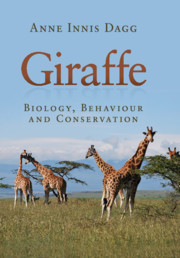Book contents
- Frontmatter
- Dedication
- Contents
- Preface
- Acknowledgements
- List of abbreviations
- 1 Time-line of giraffe
- 2 The giraffe’s environment
- 3 Feeding in the wild
- 4 Social behaviour and populations
- 5 Individual behaviours
- 6 External features
- 7 Anatomy
- 8 Physiology
- 9 Pregnancy, growth, reproduction and aging
- 10 Giraffe in zoos
- 11 Status and conservation of giraffe races
- Appendix Parasites and pathogens
- References
- Index
9 - Pregnancy, growth, reproduction and aging
Published online by Cambridge University Press: 05 February 2014
- Frontmatter
- Dedication
- Contents
- Preface
- Acknowledgements
- List of abbreviations
- 1 Time-line of giraffe
- 2 The giraffe’s environment
- 3 Feeding in the wild
- 4 Social behaviour and populations
- 5 Individual behaviours
- 6 External features
- 7 Anatomy
- 8 Physiology
- 9 Pregnancy, growth, reproduction and aging
- 10 Giraffe in zoos
- 11 Status and conservation of giraffe races
- Appendix Parasites and pathogens
- References
- Index
Summary
Pregnancy
Giraffe mothers get a bad rap. In zoos they sometimes turn against their new baby, step on it by mistake or refuse to nurse it. In the wild they have been accused of leaving their infants alone and vulnerable in the bush. However, as we see in this chapter, giraffe cows are admirable, hard-working mothers even if their behaviour is sometimes suspect when they are forced to live in captivity. Most are already pregnant again while tending to and nursing their current youngster, so there is little respite during their altruistic motherhoods. They give birth and nurse these young until they die. And when an infant itself perishes, its mother may be deeply upset, as we shall see. An adult cow giraffe comes into oestrus for the first time when she is about 3 years and 9 months old, and she continues cycling every 2 weeks until she becomes pregnant (Berry and Bercovitch, 2013). A female mates with a male when she is in oestrus but at no other time. In Zambia, the average age of first parturition for Thornicroft’s giraffe was 6.4 years (n = 6). The oldest cow known to give birth was about 24 years of age; she disappeared a year later (Bercovitch and Berry, 2009b).
The average gestation period for giraffe is about 446–457 days (del Castillo et al., 2005), although Rothschild’s pregnancies in captivity lasted about 470 days (n = 6) (Lueders et al., 2009b). About 3 weeks after giving birth, a giraffe comes into oestrus again while she is still nursing her calf, so theoretically she could bear and raise 10 young in her lifetime if one were born every 18 months. Cows do continue to reproduce for the rest of their lives, with an average interbirth interval of 22.6 months for Thornicroft’s and Masai giraffe (Leuthold and Leuthold, 1978; Bercovitch and Berry, 2009b). After giving birth, three females became pregnant in 19, 23 and 27 days, but of course continued suckling their recently born calf (Hall-Martin and Skinner, 1978). Twins are rare, and both seldom survive. Twins that have thrived were born in 2007 at the Bioparc Zoo Doué in France (Gay, 2009); one nursed from its mother while the other was bottle-fed.
- Type
- Chapter
- Information
- GiraffeBiology, Behaviour and Conservation, pp. 135 - 152Publisher: Cambridge University PressPrint publication year: 2014



